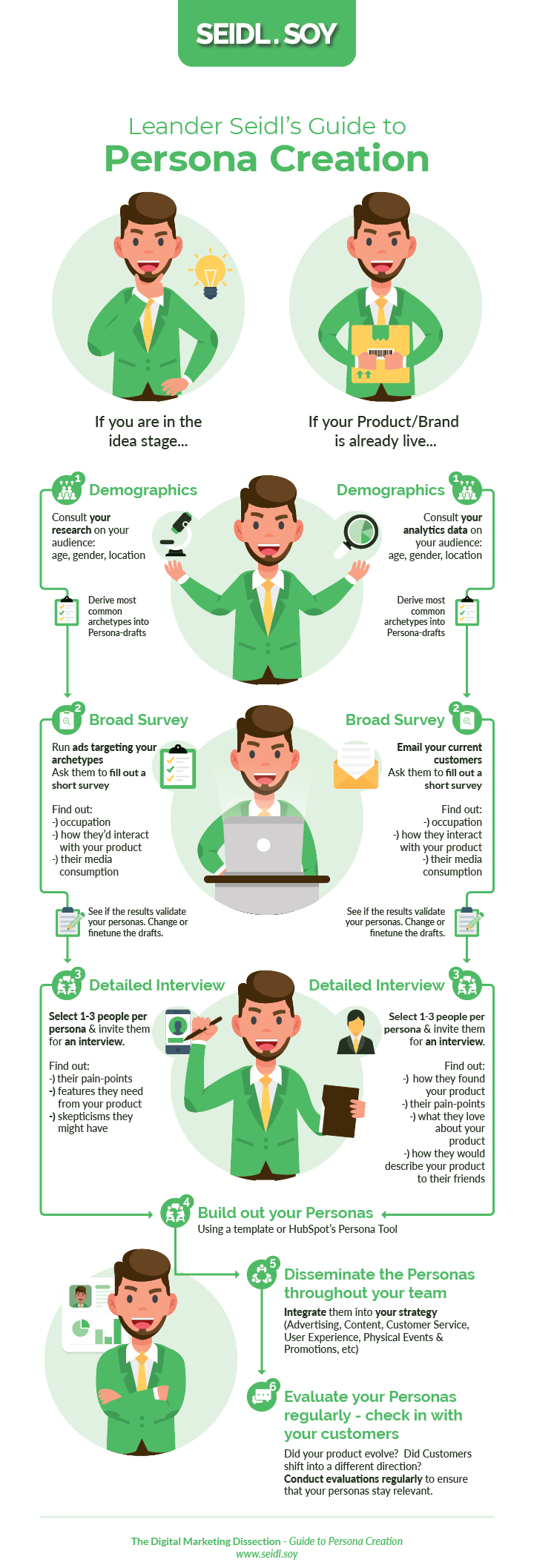In last week’s Episode of the Digital Marketing Dissection, I discussed the importance of defining a target audience – and why building out Customer Personas is a great way to do just that.
Today, I want to look at the process of defining Customer Personas in some more detail. I’ve broken down the steps needed to build Personas that are meaningful and rooted in data. I believe that the general approach is the same for all kinds of business – no matter the size and vertical. However, there is one essential question, that will affect your approach:
Is your product already live – meaning you can work with real data that you’ve collected from actual customers – or are you still in the conceptual stage?
In both cases, you can follow the same process – I’ll highlight the differences as we move through the steps.
The end of this process should be three to five distinct customer avatars – who should be as good a representation as possible of your different customers.
First of all, I’ve visualised the process in this handy infographic:

Step 1: Demographics & Basic Archetypes
Getting started, it’s important to develop an understanding of the demographic characteristics of your customer base: where do they live? What age groups are they from? How is the gender divide among your users? Based on how common each of those data points are in your audience, you can already derive some rough archetypes of your customers.
If you already have a live product, you have a huge advantage: Google Analytics and – less known, but an equally valuable data source – Facebook Analytics can give you accurate insights into your customers.
In case you are still at the pre-launch stage of your project, you’re going to have to take a different approach: look back to your initial market research. There, you will certainly find some rough data points. However: be sure to come back after a few months and refine the Personas, as real data comes in.
With the data you collect, you should try to deduce three, four or five separate archetypes – everything from gender to occupation, current location, and age. For the time being, you can simply build them out in a spreadsheet or a plain text document – we’ll make them look pretty once we have collected more data!
Step 2: Broad Survey
You should now have some rough outlines for your Personas, that reflect the Demographic makeup of your audience. In this step, it’s all about getting to know your customers better on a macro level: by doing a broad survey, asking as many customers (or potential customers) as possible.
As a marketer for an active product, you’re in luck: utilizing your email list of existing customers by asking them to fill out a survey (perhaps with the incentive of a small reward) should lead to some valuable results.
If your product is not live yet, you should use the demographics defined earlier and target them with ads – Facebook allows you to target customers very precisely, and you should be able to reach your potential customers. The challenge you have to overcome here is that people won’t feel loyalty and attachment to your brand yet – so the reward you offer them must be more attractive. Amazon vouchers or similar easily redeemable coupons often work well in these cases!
In your questionnaire, you want to find out information that you can use to build up on the demographic outlines that you’ve already defined: you’ll ask questions about age, gender, and occupation (in order to accurately sort them into your Persona-outlines), but also questions about their interactions with your product – what do they like about it, why do they use it? Another question that I like to include is about their media consumption. Identifying their most trusted news source regarding your vertical is going to help you tailor your marketing efforts later on! Finally, I recommend that you ask them for an email address so you can contact them later on – you’ll need this for the next step.
Once you’ve collected enough survey responses, its time to sort the answers into your different Persona-drafts. Not every answer will fit perfectly, but if your outlines from Step 1 were precise enough, your data should fit together quite nicely.
Step 3: Detailed Interview
So now that you have several Persona outlines, enriched with survey responses, it’s time to get in touch with some survey takers and ask them for a detailed interview via Skype. I recommend talking to at least two people per Persona – so you should email at least five of your survey takers that fit one of the Personas, in order to be sure to get enough responses.
The interview should be an open conversation with them, but it’s good to have a number of predefined questions that you want to find answers for. I recommend: how they found your product initially, their pain-points in regards to your product, what they love about your product, how they would describe your product to their friends, skepticisms they might have.
This step might take a bit of time – but speaking to real (potential) customers of your product is essential in order to create a product that’s not just beloved by yourself, but also by them! At the end of this step, your draft Personas should be all set, data-wise – you now should have a good understanding of who each of your customer archetypes are, and what makes them tick.
Step 4: Build out your Personas
This might be the most fun part: now you can take all the data you’ve collected and turn it into actual, visualized, profiles. There are several ways of doing this: you could utilize HubSpot’s Persona Generator or you could go for a template, like the one from Filestage or the one from Digitalmarketer.com (this one I appreciate, since it’s not locked behind an email gate – a rare sight these days!).
Each of those tools and templates will allow you to create visually appealing, succinct Personas – now it’s time to share them with the team!
Step 5: Disseminate the Personas throughout your team
In order for your Personas to be of maximum value, you need to make sure they are taken into consideration all over your company. Using them in your marketing team is the obvious starting point, but likewise, they should be kept in mind by your product designers, as well as your customer support representatives – and anybody else who shapes the experience of your customers and prospects.
Step 6: Evaluate your Personas regularly – check in with your customers
We live in dynamic times. Your product and your audience will be constantly evolving. Therefore, it’s essential to look into the state of your Personas regularly as well. Every three to six months, you should check your analytics data for changes of the demographic makeup (I mean, actually – you should be checking your analytics data much more regularly than that anyway), and contact a sample of your customers.
And that’s it – with this approach, you should have some awesome, up-to-date and nice-to-look-at Personas, that are based on actual insights.
What do you think? Do you go about creating your Personas in the same way? Or is your approach a different one? Let me know in the comments!



